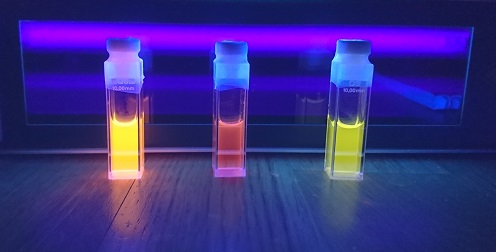Breakthrough: Researchers find the key to making fluorescent silver
A fluorescent blend of silver and DNA could help us better understand diseases. University of Copenhagen researchers have crystallized a compound with properties that could make it an effective tool for tissue and cell imaging – one that might contribute towards satisfying high global demand for a broader range of dyes. By crystallizing the compound, the researchers now hold the key to its properties and further development of new and improved versions.

"When working with tissue and studying how the cells within it behave - such as how often cells divide - it is crucial for me to be able to see them. Fluorescent dyes are indispensable in this pursuit," says stem cell researcher Marianne Stemann Andersen of Jensen Group at the University of Copenhagen, whose research includes understanding the development of skin and colon cancer, and what the roles of stem cells are within these two organs.
She is therefore pleased to hear that researchers at the Department of Chemistry have made a breakthrough in the development of a new type of fluorescent dyes based on silver and DNA.
Demand among researchers for a broader range of fluorescent dyes is high since they have become a tool in a growing number of research fields.
"People use fluorescent dyes in hundreds of areas. For example, to study a specific protein within a cell, you hook it up to a fluorescent molecule, and when illuminated, the protein lights up. This makes the invisible visible," according to Tom Vosch of the University of Copenhagen’s Department of Chemistry.
Tom Vosch and Cecilia Cerretani specialize in developing new types of fluorescent molecules that can serve as dyes. They produced a fluorescent compound that, in this case, consists of the unusual combination of silver atoms - forming a nanocluster composed of 16 atoms - and DNA. Particularly, the investigated nanocluster is wrapped in two DNA strands that serve as a scaffold to stabilize the atoms. The tiny silver clusters are biocompatible, water-soluble and have advantageous photophysical properties. When operating on the nanoscale, many materials have unique properties that they do not otherwise exhibit. Silver, for example, becomes fluorescent when it forms structures such as nanoclusters.
Like winning the lottery
Researchers around the world have tried to determine the exact structure of DNA-stabilized silver nanoclusters since 2004. Now, the Copenhagen-based research team has succeeded in crystallizing one of the clusters, which involves a certain amount of luck, akin to winning the lottery. This was achieved in collaboration with two Japanese researchers, Jiro Kondo and Hiroki Kanazawa. As a result, the researchers are now equipped to understand the compound and improve upon it.
"Now that we know the structure, we can design new clusters in a more intelligent way as opposed to the trial-and-error approach we had to settle for until now. This opens up an enormous number of previously unavailable research opportunities," Tom Vosch points out.
"These particular clusters are so stable that you can store them in a fridge for years, without them changing. Furthermore, they emit a very strong near-infrared light, when irradiated with green light. Finally, they are easy to produce," comments Cecilia Cerretani.
"By using different types of dyes in different ways, one can study various properties in cells and tissues. Having a toolbox equipped with many fluorescent molecules is advantageous, which is why it is important to continue researching the production of new types. For us, the next important step would be to test how these silver nanoclusters could be advantageously integrated into our current toolbox," says Marianne Stemann Andersen.
Related News
Contact
Tom Vosch
Associate Professor
Department of Chemistry
University of Copenhagen
tom@chem.ku.dk
+45 35 32 03 13
Cecilia Cerretani
PhD fellow
Department of Chemistry
University of Copenhagen
cece@chem.ku.dk
+45 35 33 41 22
Maria Hornbek
Journalist
The Faculty of Science
University of Copenhagen
maho@science.ku.dk
+45 22 95 42 83
Facts
- The study was conducted by: Cecilia Cerretani and Tom Vosch, Department of Chemistry and Nanoscience Center at the University of Copenhagen; Hiroki Kanazawa and Jiro Kondo, Department of Materials and Life Sciences at Sophia University, Japan.
- The research article is published in the scientific journal Angewandte Chemie International Edition.
- A fluorescent molecule – known as a fluorophore – is a compound that can absorb energy, such as light, and re-emit it as a different coloured light.
- The fluorescent compound developed by the research team consists of 16 silver atoms wrapped in two DNA strands that serve as a scaffold to stabilize the atoms. The molecule emits a strong near-infrared light when irradiated with a green light.
